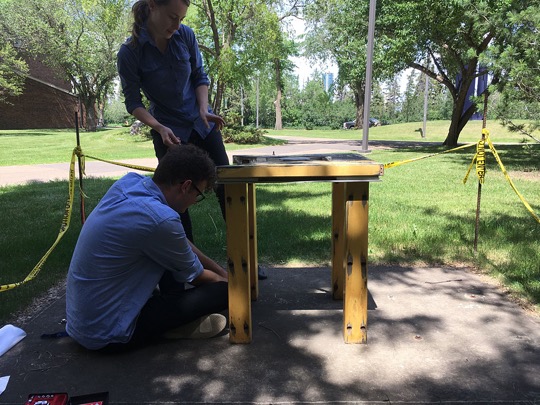2018 UAM Summer Internship: Conserving Against Time
Martin Bierens - 5 July 2018

Removing a piece of public art with Emerald Johnstone-Bedell, Assistant Curator of the University of Alberta Art Collection. Formerly located north of BioSci, it is in the process of being deaccessioned.
This past week I have been working with Jennifer Bowser here at MACS. Jenn is our Collections Management Advisor, with a specialization in registration/preventative conservation.
Preventative conservation is a very important aspect of museum practice which needs to be undertaken in order to ensure the long-term preservation of objects in the University’s collections. Essentially, preventative conservation is what the name suggests: in a museum environment once an object is received, measures are taken to ensure that it will stay in the same condition that it was received for as long as possible. This is especially important due to the nature of many collections at the University. Preventative conservation is important to the health of teaching and research collections which are handled and used frequently. These measures can include regular cleaning, condition reporting, protective storage, and of course careful care and handling of museum objects. The main concept of preventative conservation is to catch issues which may lead to deterioration of the object before they become a problem, rather than allow them to progress to a point where there is permanent damage. Of course, this is at times impossible but it is the job of specialized museum professionals to prevent this deterioration as much as they can.
There are other factors rather than just the passing of time that come into play and affect the stability of a museum object. These other factors are called the agents of deterioration. There are 10 agents of deterioration and they are: fire, water, pollutants, physical forces (such as dropping the object), pests, light damage, incorrect humidity, thieves and vandals, incorrect temperature, and dissociation which is the loss of valuable information pertaining to the object. The agents of deterioration are internationally recognized in museum practise.
Damage from the agents of deterioration can occur over time from factors such as improper storage conditions, or through unexpected events, such as a fire, flood, or theft. It is important to protect against these agents as severe deterioration can even lead to the need to deaccession (remove) an object from a museum collection, a process that all museums try their best to avoid. For example, this is what happened recently to a piece of public art on the University of Alberta campus. Due to damage from vandalism and pests, a work of art that originally consisted of two chairs and a small table located on the north side of the Biological Sciences Building had to be removed from public display. The University will soon begin the process to permanently remove it from the collection as the damage is irreparable.
Some other preventative conservation projects I have worked on this week include:
- Cleaning of the Dentistry exhibit in Edmonton Clinic Health Academy
- Labeling and inventory check of Pathology Gross Teaching Collection
- Preparation of archival materials handout as reference for curators
As an emerging museum professional, it is of course my wish that all museums are able to keep every object in excellent condition and that none are ever damaged. Unfortunately, this is impossible as accidents and unforeseeable events do occur. But through working with Jenn and others at the UofA Museums, I have seen many ways in which to prevent deterioration before it becomes an issue and ensure the care and longevity of museum objects.